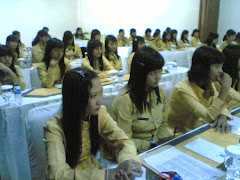Self knowledge and goals: In order to manage your time successfully, having an awareness of what your goals are will assist you in prioritizing your activities.
Developing and maintaining a personal, flexible schedule: Time management provides you with the opportunity to create a schedule that works for you, not for others. This personal attention gives you the flexibility to include the things that are most important to you.
Sabtu, 16 Mei 2009
Jumat, 15 Mei 2009
Yogyakarta
Yogyakarta (some people call it Jogja, Jogjakarta, or Yogya) is a city with outstanding historical and cultural heritage. Yogyakarta was the centre of the Mataram Dynasty (1575-1640), and until now the kraton (the sultan's palace) exists in its real functions. Also, Yogyakarta has numerous thousand-year-old temples as inheritances of the great ancient kingdoms, such as Borobudur temple established in the ninth century by the dynasty of Syailendra.
More than the cultural heritages, Yogyakarta has beautiful natural panorama. The green rice fields cover the suburban areas with a background of the Merapi Mountain. The natural beaches can be easily found to the south of Yogyakarta.
Here the society lives in peace and has typical Javanese hospitality. Just try to go around the city by bike, pedicab, or horse cart; and you will find sincere smiles and warm greeting in every corner of the city.
An artistic atmosphere is deeply felt in Yogyakarta. Malioboro, as the center of Yogyakarta, is overwhelmed by handicraft from all around the city. Street musicians always ready entertain the visitors of the lesehan food stalls.
Those who have visited Yogyakarta reveal that this city makes them long for it. Just visit here, then you will understand what this means.
Transportations to Yogyakarta:
Train
You may reach Yogyakarta by train from Jakarta, Bandung, or Surabaya
Bus
Yogyakarta is reachable by bus from Sumatra Island, Bali Island, and most cities of Java Island.
Plane
Recently, international direct flights from Kuala Lumpur are established to Yogyakarta. In addition, domestic flights to Yogyakarta from Jakarta, Denpasar, Balikpapan, and many others, are available now
More than the cultural heritages, Yogyakarta has beautiful natural panorama. The green rice fields cover the suburban areas with a background of the Merapi Mountain. The natural beaches can be easily found to the south of Yogyakarta.
Here the society lives in peace and has typical Javanese hospitality. Just try to go around the city by bike, pedicab, or horse cart; and you will find sincere smiles and warm greeting in every corner of the city.
An artistic atmosphere is deeply felt in Yogyakarta. Malioboro, as the center of Yogyakarta, is overwhelmed by handicraft from all around the city. Street musicians always ready entertain the visitors of the lesehan food stalls.
Those who have visited Yogyakarta reveal that this city makes them long for it. Just visit here, then you will understand what this means.
Transportations to Yogyakarta:
Train
You may reach Yogyakarta by train from Jakarta, Bandung, or Surabaya
Bus
Yogyakarta is reachable by bus from Sumatra Island, Bali Island, and most cities of Java Island.
Plane
Recently, international direct flights from Kuala Lumpur are established to Yogyakarta. In addition, domestic flights to Yogyakarta from Jakarta, Denpasar, Balikpapan, and many others, are available now
On The Job Training
It is the responsibility of supervisors and managers to utilize available resources to train, qualify, and develop their employees.
On-the-job training (OJT) is one of the best training methods because it is planned, organized, and conducted at the employee's worksite. OJT will generally be the primary method used for broadening employee skills and increasing productivity. It is particularly appropriate for developing proficiency skills unique to an employee's job - especially jobs that are relatively easy to learn and require locally-owned equipment and facilities.
Morale, productivity, and professionalism will normally be high in those organizations that employ a sound OJT program.
An analysis of the major job requirements (identified in the position description and performance plan) and related knowledges, skills, and abilities form the basis for setting up an OJT plan. To be most effective, an OJT plan should include:
The subject to be covered;
Number of hours;
Estimated completion date; and
Method by which the training will be evaluated
To have a successful OJT program, supervisors need to assign a coach to each employee involved in OJT. It is the responsibility of the coach to plan training carefully and conduct it effectively.
On-the-job training (OJT) is one of the best training methods because it is planned, organized, and conducted at the employee's worksite. OJT will generally be the primary method used for broadening employee skills and increasing productivity. It is particularly appropriate for developing proficiency skills unique to an employee's job - especially jobs that are relatively easy to learn and require locally-owned equipment and facilities.
Morale, productivity, and professionalism will normally be high in those organizations that employ a sound OJT program.
An analysis of the major job requirements (identified in the position description and performance plan) and related knowledges, skills, and abilities form the basis for setting up an OJT plan. To be most effective, an OJT plan should include:
The subject to be covered;
Number of hours;
Estimated completion date; and
Method by which the training will be evaluated
To have a successful OJT program, supervisors need to assign a coach to each employee involved in OJT. It is the responsibility of the coach to plan training carefully and conduct it effectively.
.jpg)


.jpg)
